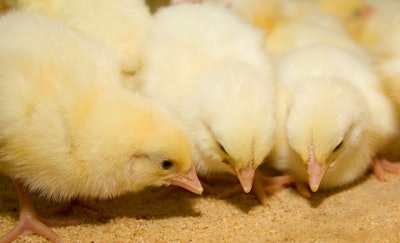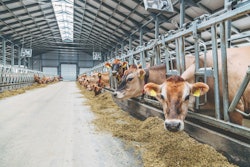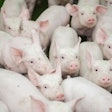
Broiler producers continue to pay increasing attention to early nutrition developments
When broilers were marketed at 56 days, the starter phase lasted up to two weeks, and chicks had some time to make up for any rough early start due to late placement or inappropriate feeding methods.
Now that broilers are marketed at 42 days or even less, every day counts more and there is no time for catching up or correcting mistakes. Indeed, repeated research has shown that appropriate management and nutrition during the first week, or even the first four days, post-hatch can positively affect the end performance result by us much as 10%. That is, birds can grow either up to 10% more efficiently or faster throughout their life.
So, a boosted early start has longer-term beneficial repercussions, and this is being realized (slowly but steadily) by the poultry industry. First to capitalize on this effect are small- and medium-sized producers who can react faster, whereas large ones are more reluctant as they depend less on labor and individual bird (or batch) performance and more on facility volume and throughput.
Nevertheless, specialty super broiler pre-starters, to be fed the first four days post-hatch, are being slowly introduced in the market. These “0-4 feeds” can be fed up to seven days, but their cost-to-benefit relationship is capitalized better when fed during the very first few days post-hatch.
In most of the cases, these specialty feeds are fed in crumble form, and they can include a variety of ingredients and additives that are cost prohibitive for older birds. But, when fed at such an early age, they allow for a rapid development of the gut digestive system, boost overall immunity and health and, in general, improve chick quality. Lamentably, research on this critical phase of a broiler’s life remains scarce and inadequate.
All significant research remains the proprietary right of commercial entities that invested in it and now want to reap the dividends of their investment. A few (remaining) truly public research institutions attempt to investigate this new frontier in nutrition, and the remainder of this discussion will present those that were reported during the past European Symposium on Poultry Nutrition, held in Gdansk, Poland, during June 2019.
-
Timing of first feeding is important (Abstract 6.28; Kang et al., page 297)
A South Korean research group investigated the timing of the first feeding on lifelong broiler performance. It was revealed that offering feed almost immediately post-hatch (3 hours) significantly improved feed intake and body weight at day 21, compared to offering first feed at a later time – 12, 24, 36 or 48 hours). Whereas the latter two timing treatments might seem exaggerated, they occur when chicks must travel significant distances between the hatcheries and growing facilities. In addition, the above researchers verified that early feeding enhanced gut maturity and blood biochemical profile, all leading to a better chick. From this research, it appears that 12 hours is a golden compromise, but 24 hours and above is where we must pay attention as we start stressing the chick irrevocably.
-
Fat quality affects digestibility (Abstract 6.25; Jimenez-Moya et al., page 296)
Spanish researchers investigated the quality of fats offered during the early life of broilers. They fed diets varying in degree of fat saturation (from 15% to 38%) and free-fatty acid (FFA) content (from 11% to 67%). They found out two significant aspects: first, as the degree of saturation increased, total fat digestibility dropped and that saturated fatty acids were poorly digested – as low as 22%; second, as the concentration of FFA increased, it was only the digestibility of short-chain fatty acids that was negatively affected. The conclusion was that saturation degree in early life plays a more significant role than FFA concentration. These findings are in agreement with established facts in piglet nutrition.
-
High density versus highly digestible prestarter feeds (Abstract 6.14; Panheleux-Lebastard et al., page 290)
A very common question was asked by French nutrition company CCPA Group that tested two principles as early broiler nutrition (first week post-hatch): a high-nutrient density diet or a highly digestible diet. Of course, there was a negative control, and even a super-concentrated fourth treatment to ensure nutrient concentration was not limiting. The answer was rather clear: Birds receiving more digestible feed during the first week post-hatch were heavier than control birds and even those offered more dense diets (in terms of amino acids and energy). And, this benefit carried over all the way to the end. It was also mentioned that early bird nutrition was also seen to affect meat quality, but this requires further investigation.
-
Calcium and plasma effects in 0-4 feeds (Abstract 6.1; Franco-Rosello et al., page 284)
A commercial research report by Trouw Nutrition investigated the role of low-calcium diets with or without animal plasma fed during the first four days post-hatch on overall chick growth at 35 days of age. Feeding a low-calcium diet improved final body weight, whereas added animal plasma did not offer further benefits in this regard, although it did improve feed conversion rate. In addition, animal plasma significantly reduced bird mortality. Lamentably, the experimental design did not include a fourth treatment where only animal plasma was included over the control diet to distinguish the true effects of animal plasma. Still, this study remains good enough as it serves to verify what we expected from a more digestible diet. The low-calcium diet concept is similar to what we already apply to piglet early nutrition – but for different reasons.
-
Specialty soya and coccidiosis (Abstract 1.16; Schulze et al., page 168)
In agreement with previous trials, a research report by Agilia (AB Group) indicated that feeding a specialty processed soybean meal early in life can offer significant life-term benefits in healthy birds. Although the experimental design did not allow sufficient damage by coccidia to manifest, there was sufficient evidence to suggest that specialty soy products may partially alleviate the negative effects of coccidiosis. For that, more studies are needed, but again, this report points to the right direction on how we should be feeding healthy and challenged birds early in life.
There was also another study with a similar product reported by Hamlet Protein, pointing to similar results using Asian genetics fed over a longer period of time.


















